Join More Than 50,000+ Subscribers and get latest camera news and rumors
NEW CAMERA VIDEOS ON YOUTUBE
Download Our Android App
|
By admin, on December 17th, 2018
We have selected some of the best Christmas deals for you. The best season to buy digital cameras and gifts for your loved ones and yourself. We are able to find out very few real deals, the deals we have selected have big discount on their MSRP as well as you are getting a extra Lens with your camera as a gift. Take a look at the set of amazing deals we have found for you
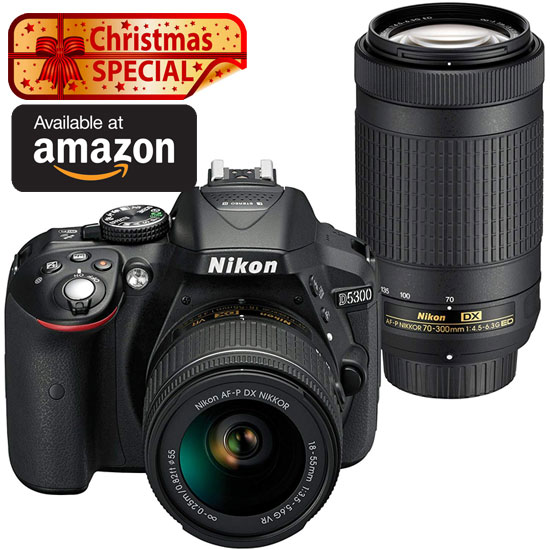
1. Nikon D5300 DSLR Camera + 75-300mm Lens @ $496 Only
Nikon D5300 is a Mid-range camera and available at $496 only. The Big difference you get from Nikon D3500 ($496 Amazon) is its advance 39 Point AF system and Built-in WIFI with GPS. Nikon D3500 features 11 Point AF system and limited wireless transfer option with Bluetooth connectivity. We have No built-in GPS in Nikon D3500. So, Overall Nikon D5300 is a excellent option under $500, but got a limited period of time.
Get Nikon D5300 offer from Amazon.com
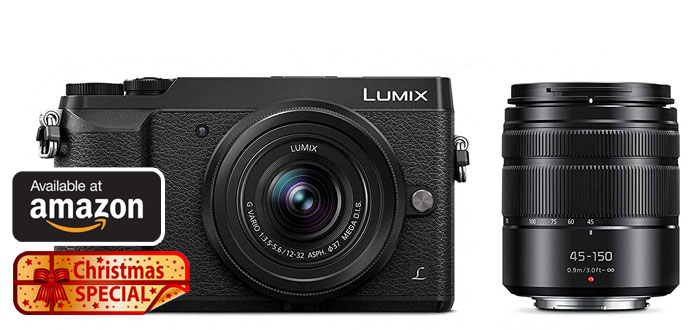
2. Panasonic GX85 4K with 5-axis IS + Kit Lens 12-32mm and FREE 45-150mm lens @ $497
The best camera if you are a Youtuber as well as a Still Shooter, its a Hybrid camera that satisfy all your need. Amazon.com is giving out flat $500 discount on Camera and Lens bundle.
Get Panasonic G85 Camera with Kit Lens Bundles @ $497 at Amazon.com [Limited time]
By admin, on November 23rd, 2013
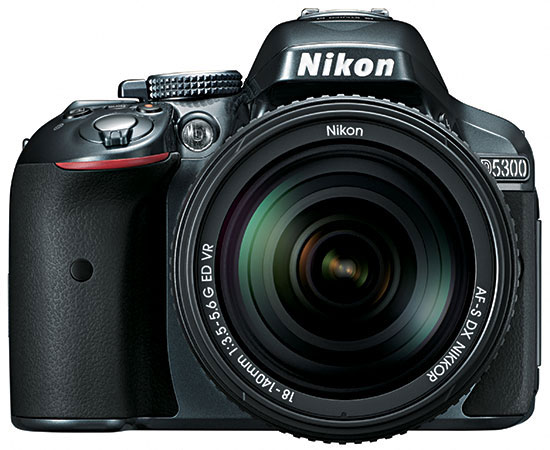
Nikon D5300 DSLR features 24.2MP DX-Format Sensor, EXPEED 4 Processor and Multi-CAM 4800DX Autofocus Sensor other features include Wi-Fi and GPS Connectivity.
All lenses listed here are fully compatible with your DX format D5300 DSLR and will do Full time AF in Still and Video mode, we only have one FX format lens in our list – 50mm F1.8 for portrait purpose, Since we have no other option (no 50mm lens available for DX format camera from Nikon). But keep in mind that 50mm F1.8 lens is a AF-S Lens and it will do AF with your D5200 DSLR.
Best All in one Third Party Lens
Sigma 18-35mm f/1.8 DC HSM Art Lens
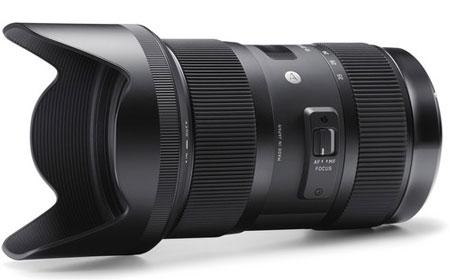
Sigma 18-35mm F1.8 DC HSM Art Lens from Amazon & B&H
Before we begin with our standard Lens recommendation I must tell you the name of best Lens I have ever used with My Nikon D5300 camera, The lens captures excellent images, the focal length of the lens covers a very essential distance and Sigma 18-35mm lens can be used for a wide variety of applications, from Landscape, Architecture or portraits. Focus is not only sharp, but extremely sharp. The bokeh is so creamy. Sigma made a exceptional lens.
All-rounder / multi-purpose lens for Nikon 5300
Nikon 18-200mm f/3.5-5.6G ED VR II lens
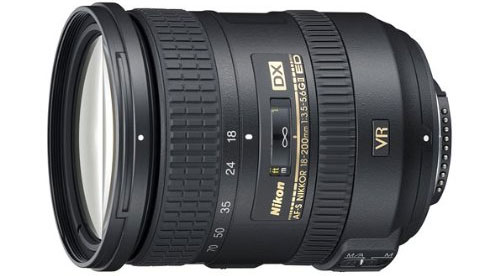
Buy Nikon 18-200mm ED VRII Lens from Amazon
With Nikon 18-200mm you get more range and VRII image stabilization but you have to pay more money, the lens features excellent sharpness at tele and wide end. The bokeh of this lens is nice and smooth and on the core specification side we have 2 Extra-low Dispersion (ED) elements, 3 aspherical lens elements to correct chromatic aberrations and lens aberration, other features include Zoom lock switch, Nikon Super Integrated Coating (SIC) to reduced flare. Overall the Nikon 18-200mm is best travel lens for Nikon D5300 DSLR.
The Good: Covers a wide range, sharp at wide end and tele end, at 18mm image quality at corner is bit soft, VRII image stabilization system.
The Bad: Price & bit heavy.
Zoom Lens for Nikon D5200
Nikon 55-300mm f/4.5-5.6G ED VR AF-S DX
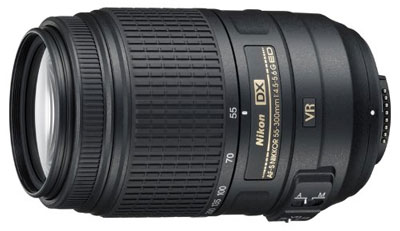
Buy Nikon 55-300mm ED VR AF-S DX Amazon
Nikon 55-300mm lens image quality is excellent and available at $399, the lens captures sharp images at tele+ wide-end and also comes with VRII image stabilization, The build is plasticy but inside we have 2 Extra-low Dispersion (ED) Elements to minimize to chromatic aberrations, HRI (High Refractive Index) Lens Element, New Tripod Detection Mode to stop optical IS when Tripod is used, Nikon Silent Wave Motor (SWM) for fast, accurate and quiet autofocus and 7-blade rounded diaphragm provides more natural out-of-focus blurred background. Nikon 55-300mm is Excellent Zoom Lens for Nikon D5300 DSLR.
The Good: Excellent Image Quality, 300mm range and Affordable
The Bad: Minor distortion issue at tele-end as other zoom lenses.
Portrait Lens for Nikon D5300
Nikon 50mm AF-S F1.8 FX Lens
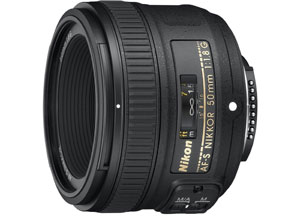
Buy Nikon 50mm AF-S F1.8 Lens from Amazon
Nikon 50mm AF-S F1.8 FX Lens will work as a (50 X 1.5) 75mm lens in your D5300 DSLR due to sensor crop factor, in-return you get more working distance and creamy background blur in your images. Recommend for anyone who is beginner in photography and interested in first prime lenses for portrait and low light shooting.
The good: excellent image quality, sharp images with smooth background.
The Bad: None
We have one more recommendation here, Nikon 35mm F1.8 covers more range and suitable for friends and family shooting under low light condition, you can also use Nikon 35mm as a portrait lens.
Macro Lens for D5300
Nikon 40mm f/2.8G AF-S DX
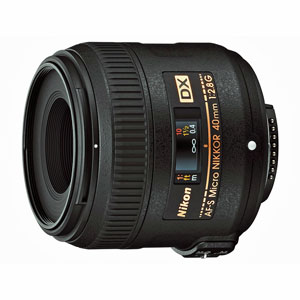
Buy Nikon 40mm F2.8 AF-S DX from Amazon
Nikon 40mm f/2.8G AF-S DX is Highly recommended lens for your Nikon D5300 DSLR, the 40mm lens gives razor sharp images, excellent background blur (Bokeh) and features Nikon SWM motor for fast and accurate Auto focus. The 40mm lens can be also used for portrait and low-light photography.
The Good: Sharp images, affordable
The Bad: None
Wide angle Lens for Nikon D5300
Nikon 10-24mm f/3.5-4.5G ED AF-S DX
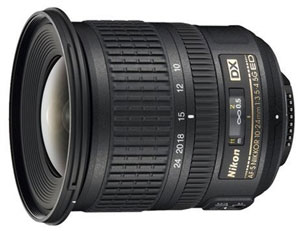
Buy Nikon 10-24mm from Amazon
Nikon 10-24mm f/3.5-4.5G ED AF-S DX is the best Wide angle Lens for Nikon D5300, the 10-24mm is a DX format lens made for DX format camera like Nikon D3200 and D7100, the lens images are sharp and it captures excellent color and contrast, the lens comes with Two ED (Extra-low Dispersion) glass elements to fight with chromatic aberration and Three aspherical lens elements to minimize coma and other types of lens aberration.
The 10-24mm lens offers Close focusing to 0.8 feet and Internal Focus (IF) with Nikon SWM (Silent Wave Motor) for fast and pin-point focusing.
The Good: Solid Build, Image quality and sharpness.
The Bad: Price
You can ask you question in the comment box below
By admin, on November 17th, 2013
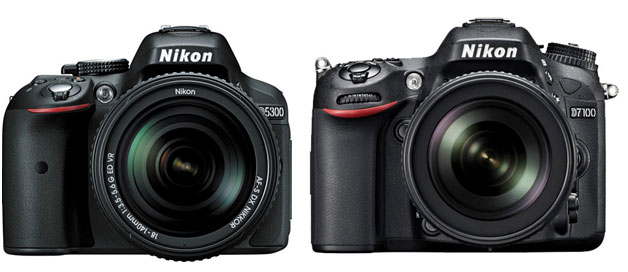 Nikon D5300 vs Nikon D7100 – You will not notice any difference in RAW image quality when you compare the Nikon D5300 and D7100 DSLRs RAW files, since both of them features same sensor, but there is a possibility that the JPEG of D5300 will have less noise than Nikon D7100 due to the use advance EXPEED 4 image processor in D5300. Take a look at the chart below + its analysis for major difference Nikon D5300 vs Nikon D7100 – You will not notice any difference in RAW image quality when you compare the Nikon D5300 and D7100 DSLRs RAW files, since both of them features same sensor, but there is a possibility that the JPEG of D5300 will have less noise than Nikon D7100 due to the use advance EXPEED 4 image processor in D5300. Take a look at the chart below + its analysis for major difference
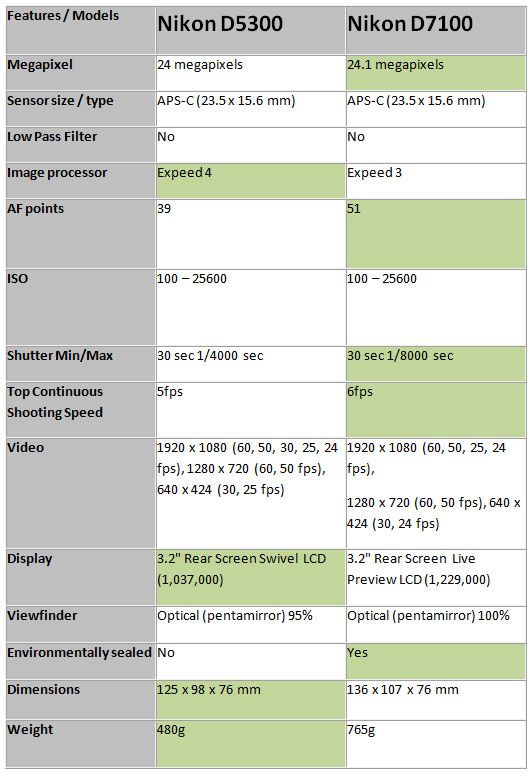 Major difference Major difference
#1 Expeed 4 image processor – You get advance image processor in Nikon D5300.
#2 Auto focus System: The Nikon D7100 features advance AF system with more AF points.
- The D5300 uses 39 point AF system – 39 distinct AF points, including nine cross-type sensors, to quickly acquire focus in a range of lighting conditions.
- The D7100 uses 51 focus points, You get 51 AF points including 15 cross-type sensors for detecting both vertical and horizontal contrast variations, to achieve fast, precise focus.
#3 Shutter: Nikon D7100 features bit fast continuous shooting speed (5 vs 6 fps) and more MAX shutter range compared to D5300 (1/4000 vs 1/8000).
#4 Swivel LCD display with Nikon D5300, Nikon D7100 have fixed display unit with bit more resolution.
#5 Rugged body: Nikon D7100 offers you rugged body, no such option available in D5300.
Verdict: As we have said in the beginning, the Nikon D5300 and Nikon D7100 will give you same image quality, but with D7100 you get bit more advance AF system.
Buy Nikon D5300 from Amazon | B&H —– Buy Nikon D7100 from Amazon | B&H
By admin, on October 25th, 2013
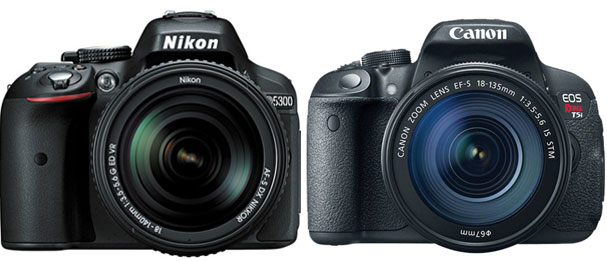 Nikon D5300 vs Canon 700D specification comparison review, Nikon D5300 features bit bigger sensor + More resolution compared to 700D / T5i, take a look at the detailed specification comparison review below. Nikon D5300 vs Canon 700D specification comparison review, Nikon D5300 features bit bigger sensor + More resolution compared to 700D / T5i, take a look at the detailed specification comparison review below.
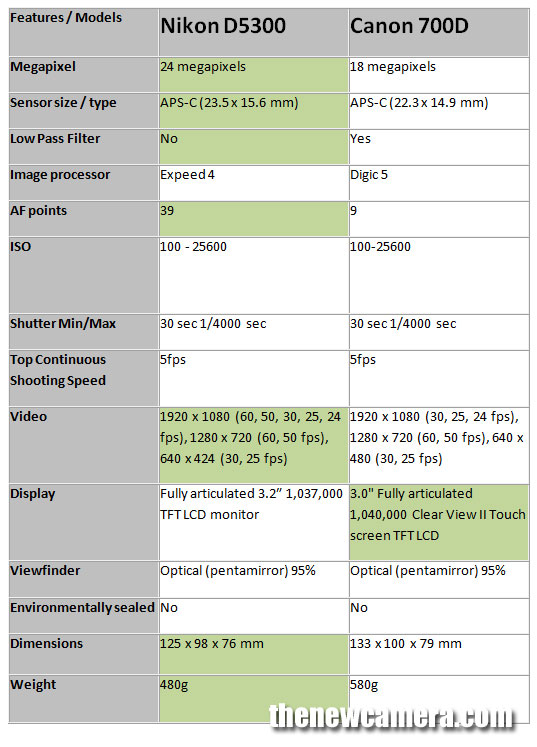
Take a look at the Major difference we found…
#1 Sensor: Nikon D5300 features 24.2 megapixel DX-format CMOS sensor same sensor as Nikon D7100 DSLR and we have seen the image quality of Nikon D7100 is excellent compared to 700D.
+ Nikon introduced a new Expeed 4 image processor with D5300, So D5300 features No optical Low-Pass filter + advance image processor compared to D7100, Nikon D5300 is a clear winner in-terms of image quality.
#2: No OPLF in D5300: The sensor design omits the traditional optical low-pass filter in order to gain the utmost sharpness and resolution from both photos and videos.
#3: AF System: Nikon D5300 features advance Phase AF system, Nikon D5300 have 39-point autofocus system, with nine cross-type sensors. Canon 700D comes with 9-point all cross-type AF system (including a high-precision dual-cross f/2.8 center point).
#4: Fast AF in Live-view & Video mode with 700D – Canon 700D newly developed Hybrid CMOS AF System is utilizes two different kinds of AF-phase and contrast detection technology, hence you get quick AF during live-view mode & in video mode, Nikon D5300 uses Contrast based AF system only in Video and live-view mode.
#5:Video: Nikon D5300 features Full HD recording @ 60fps on the other hand Canon 700D limited to 30fps at Full HD mode.
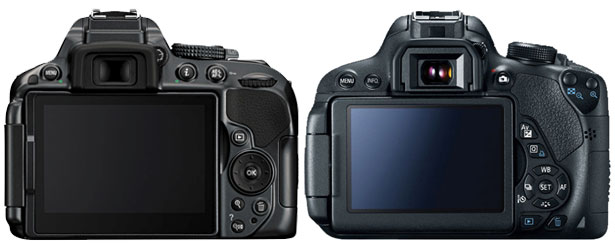
#6: Display: Canon 700D features better Touchscreen LCD with 1,040k-dot resolution, it also includes Touch Autofocus, Nikon D5300 comes with 3.2″ 1,037k-Dot Vari-Angle LCD Monitor.
# Others: Nikon D5300 features built-in Wi-Fi and GPS modules, Nikon D5300 features built in HDR capture that combines tonal and exposure range of a single image by recording two separate exposures and blending them together.
Verdict: Nikon D5300 core specification is better compared to 700D, Nikon D5300 gives you better image quality and advance Phase AF system, we recommend you to buy Nikon D5300 DSLR.
Buy / Pre-order Nikon D5300 from Amazon | B&H
Buy Canon 700D from Amazon US | Amazon UK
By admin, on October 22nd, 2013
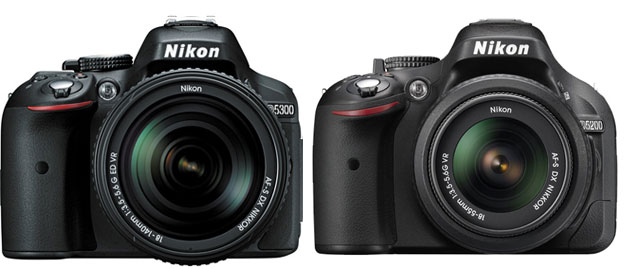
Nikon D5300 vs Nikon D5200 specification comparison, Nikon D5300 comes with new image processor, Nikon D7100 sensor and No optical low-pass filter OR AA filter. Take a look at the table below for detailed specification comparison.
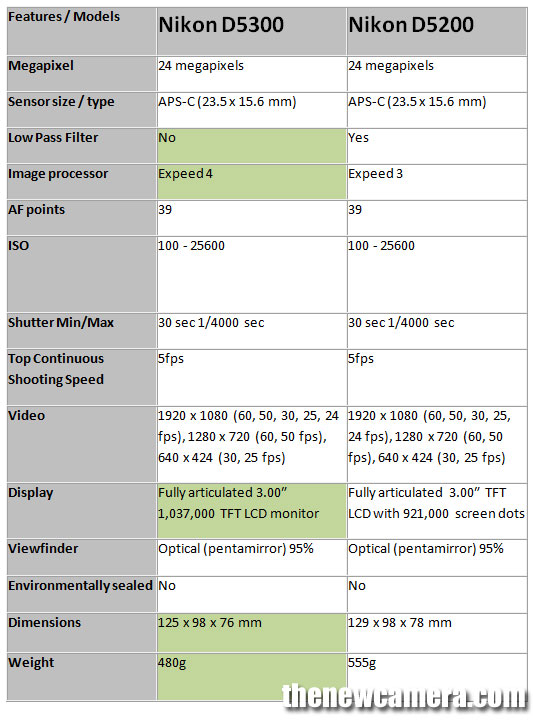
Nikon D5200 and D5300 features almost same core specification, take a look at the Major difference below,
#1:New Sensor: Nikon D5300 uses Nikon D7100 sensor, however there is now major difference in image quality when compared to Nikon D7100.
#2: No Optical Low-Pass Filter: Nikon D5300 Have no OPLF, hence you get more details when you use high-grade Nikon Lenses with D5300.
#3: New Expeed 4 processor: the new image processor is not improving the overall speed of the camera in any way or may be the processor have capabilities but bounded by software to do limited performance.
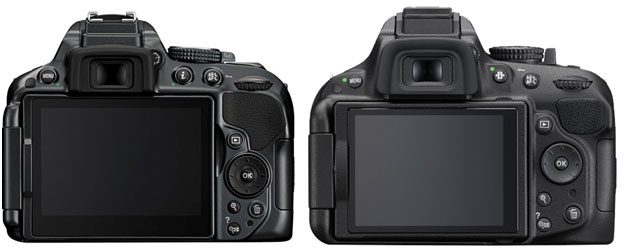
#4 Display: Nikon D5300 features more high resolution display compared to Nikon D5200.
#5: Built-In Wi-Fi and GPS Connectivity: Nikon D5300 features built in Wireless connectivity and GPS.
Verdict: We recommend Nikon D5100, Nikon D3100 and Nikon D3200 users to buy new Nikon D5300 DSLR, but we also recommend D5200 users to wait for Nikon D5400 (D5300 successor).
Buy / Pre-order Nikon D5300 from Amazon | B&H
By admin, on October 19th, 2013
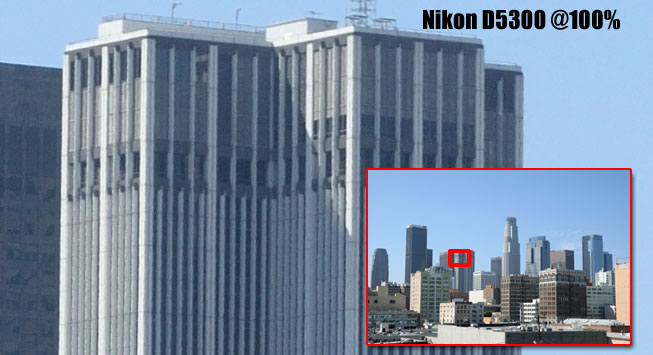 Nikon D5300 recently announced by Nikon, the Nikon D5300 features same sensor as Nikon D7100 sensor + no OPLF (optical Low-Pass Filter), as a result the images will be super sharp even when viewed at 100%. Nikon D5300 recently announced by Nikon, the Nikon D5300 features same sensor as Nikon D7100 sensor + no OPLF (optical Low-Pass Filter), as a result the images will be super sharp even when viewed at 100%.
Nikon D5300 Samples Gallery
Nikon D5300 Samples at Nikon USA website
Also see – Nikon D5300 Price, Press Release Full Specification and Videos
Nikon D5300 Price – $795 body only – Buy / Pre-order from Amazon | B&H
By admin, on October 17th, 2013

Nikon announced Nikon D5300 DSLR today, the camera features 24.1MP DX format CMOS sensor, same as NikonD7100 DSLR. The camera also comes without OLPF, other features include new Expeed 4 image processor and ISO expandable upto 25600. Take a look at the major features below
Nikon D5300 Major Features
- 24.1MP DX format CMOS sensor, without OLPF
- EXPEED 4 processing
- ISO 100-6400 standard, up to 25600 expanded
- 5 fps continuous shooting
- 39 point AF system, 9 sensors cross type
- 2016 pixel RGB metering sensor
- 1080p60 video recording, built-in stereo mic
- 1.04M dot 3.2″ vari-angle LCD monitor
- built-in wireless LAN (Wi-Fi®)
- GPS
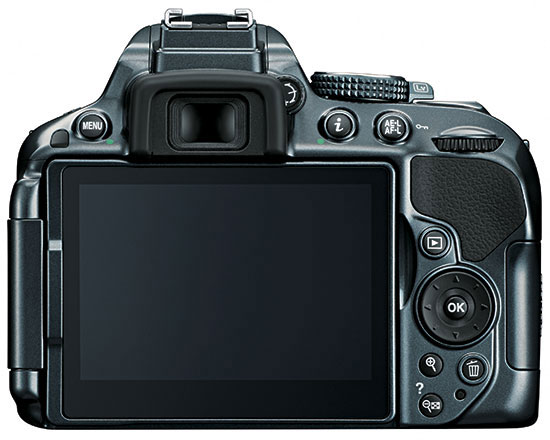 Nikon D5300 is Nikon first entry level model to come without AA filter, it will sure deliver super sharp images with high quality lenses. Nikon D5300 also comes with built in WiFi and GPS. The overall design is also smaller than Nikon D5200 DSLR . Nikon D5300 is Nikon first entry level model to come without AA filter, it will sure deliver super sharp images with high quality lenses. Nikon D5300 also comes with built in WiFi and GPS. The overall design is also smaller than Nikon D5200 DSLR .
Nikon D5300 Price –
$795 body only – Buy / Pre-order from Amazon | B&H
Store, $1399 with the 18-140mm lens
This post will be updated multiple times in the next few hours. Please refresh your browser for the latest version.
Nikon D5300 Press Release
The best image quality and definition in its class enabled by an effective pixel count of 24.2-million pixels, no optical low-pass filter, and the new EXPEED 4 image-processing engine.
An entry-level model equipped with a vari-angle monitor, and the first Nikon digital SLR camera to offer built-in Wi-Fi® and GPS functions.
TOKYO – Nikon Corporation is pleased to announce the release of the D5300, a Nikon DX-format digital SLR camera.
The D5300 is Nikon’s latest entry-level model. It offers an effective pixel count of 24.2-million pixels and is equipped with a Nikon DX-format CMOS sensor with no optical low-pass filter, as well as the new high-performance EXPEED 4 image-processing engine. It is Nikon’s first digital SLR camera to offer built-in wireless LAN (Wi-Fi®) and GPS functions, which enable simple sharing of high-quality images captured with the D5300 and NIKKOR lenses offering superior rendering performance via a smart device. These functions also allow users to look back on routes taken on vacation or with outdoor activities using a log feature that is part of the built-in GPS function.
The D5300 is also designed with a monocoque structure made of a new material that enables a smaller and lighter body while maintaining the necessary strength and durability. The camera is also equipped with a number of features that support various shooting situations, including a 3.2-inch, approximately 1037k-dot vari-angle monitor with wide viewing angle that enables flexible shooting from a variety of angles, a full-HD movie recording function that supports recording of smooth 1920 x 1080/60p movies, and a Special Effects mode with nine options that can be applied to photos and movies with shooting for a variety of creative effects.
D5300 Primary Features
- An effective pixel count of 24.2-million pixels and a Nikon DX-format CMOS sensor with no optical low-pass filter, as well as the latest image-processing engine, EXPEED 4, for the best image quality and definition in its class
The D5300 offers an effective pixel count of 24.2-million pixels and is equipped with a DX-format CMOS image sensor developed exclusively by Nikon. It supports a broad range of standard sensitivities, from ISO 100 to ISO 12800, as well as additional expansion up to ISO 25600 equivalent (Hi 1), for high-definition images exhibiting very little noise with shooting at a broad range of sensitivities. In addition, the latest image-processing engine, EXPEED 4, optimized to be even faster for high-performance digital SLR cameras, provides significantly better results with noise reduction (NR), auto white balance, color reproduction characteristics, and tone processing. What’s more, the absence of a low-pass filter maximizes the superior resolution of the high pixel count and rendering capabilities of NIKKOR lenses.
- Built-in Wi-Fi for transmitting high-quality images to a smart device for simple sharing
As Nikon’s first digital SLR camera equipped with a built-in Wi-Fi function, high-quality images with an effective pixel count of 24.2-million pixels captured from a variety of angles using the flexible vari-angle monitor can be transferred to a smart device for sharing with others*1. This expands the ways in which images are enjoyed after they are taken by enabling immediate image transfer for sharing photos with family and friends via blogs or social networking sites anytime, anywhere.
- Transfer function: Images captured by the D5300, or already saved to a memory card inserted in the D5300, can be transferred to a smart device over a wireless connection. Transferred images can be viewed in the smart device display, or uploaded to a blog or social networking site. In addition, the size at which images are transferred to a smart device can be selected from two options in accordance with smart device storage capacity.
- Manual upload function: Users can select images to be uploaded to a smart device using the D5300 monitor display. In situations or environments that do not sufficiently support immediate image upload, or when a smart device is not readily available, the camera can be used to specify images, and image file size, to be uploaded to the smart device at a later time.
- Remote shooting function: The D5300’s live view display is shown in the smart device display, enabling remote control over shooting. The camera’s live view shooting display is shown in the smart device display, allowing users to accurately frame photos and predict results with remote control over shooting*2.
- *1The Wireless Mobile Utility app must first be installed on the smart device (the app can be downloaded free of charge from the smart device’s app store).
- *2Effective only when AF-area mode is set to “Normal-area AF” or “Wide-area AF”.
- A built-in GPS function that records location data and tracks movement
The D5300 is Nikon’s first digital SLR camera with a built-in GPS function, enabling recording of location data (longitude, latitude, altitude) with images. Collaboration with ViewNX 2, NIKON IMAGE SPACE, and commercial mapping software enables display of images where they were captured on maps, as well as sharing of images with location data. What’s more, the A-GPS function makes detection of location data smoother. This capability allows users to look back on memories, or track their movement, on vacations or with outdoor activities by shooting location, and date and time of capture.
- A monocoque structure made of a new material for a smaller and lighter body that is strong and durable
The D5300 is designed with a monocoque structure utilizing a new material. As the camera cover and body are formed with a rigid, integrated structure, there are fewer joints. This enables a smaller and lighter camera with a width of 125 mm, height of 98 mm, and depth of 76 mm, and weighing just 530 g*, all while maintaining the necessary strength and durability.
- *Including battery and SD memory card; excluding body cap.
- A 3.2-in., 1037k-dot vari-angle LCD monitor with wide viewing angle for simple shooting from any angle
Adoption of a larger 3.2-inch, approximately 1037k-dot LCD monitor with wide viewing angle ensures a crisp, clear display. The side-hinged vari-angle monitor opens from 0 to 180° to the side, and can be rotated up to 90° clockwise and up to 180° counter-clockwise when it is open. This enables shooting from a wide variety of angles, from low to high, and making even self portraits possible.
- D-Movie function for recording full-HD 1920 x 1080 60p movies
The D5300 is equipped with a D-Movie function that supports recording of 1920 x 1080/60p movies. The combination of NIKKOR lenses, an effective pixel count of 24.2-million pixels, and the new EXPEED 4 image-processing engine provides movies with excellent resolution and very little in the way of noise, color aliasing, or moiré patterns. In addition, autofocusing during movie recording is possible using contrast-detect AF. When the focus mode is set to full-time-servo AF (AF-F) and AF-area mode is set to Subject-tracking AF, the camera automatically maintains focus on moving subjects. Manual movie settings are also available, allowing users to choose the desired shutter speed and ISO sensitivity in live view mode and with movie recording. Movie frame rate with full-HD recording can be selected from 24p, 25p, 30p, 50p, and 60p. In addition to recording of high-quality sound via the built-in stereo microphone, the optional Stereo Microphone ME-1 can also be used to record stereo sound.
- Toy Camera Effect and HDR Painting added to Special Effects mode (total of 9 effects) for more creative expression with still images and movies
The D5300 is equipped with a Special Effects mode, with which effects can be selected and applied with recording of both still images and movies. Preview in the camera monitor before shooting or recording begins allows users to confirm the results of effect selection in real time. Users can choose from a total of nine special effects, including the seven built into the D5200 (Selective Color, Color Sketch, Miniature Effect, Night Vision, Silhouette, High Key, Low Key), as well as the new Toy Camera Effect and HDR Painting*. This allows users to easily enjoy dramatic effects like those seen in art and the movies. This mode was adopted to respond to the creative intent of users searching for a way to express their own unique style and creativity.
- Toy Camera Effect: Create photos and movies in which colors have been changed and edges have been shaded so that they appear to have been recorded with a toy camera. Users can adjust the vividness and degree of vignetting (peripheral shading) from three options each to suit their individual preferences.
- HDR Painting*: The camera shoots two frames at different exposures and combines them, with processing that changes color tones, for HDR images with a painterly effect.
- *HDR Painting cannot be applied to movies. Further, results of the HDR Painting effect cannot be previewed in the camera monitor.
- Designed with a firm grip using just one hand and available in 3 colors, including a new gray option
The D5300 grip is designed to fit comfortably in the palm of the hand for a firm hold using just one hand, making framing via both the optical viewfinder and the monitor’s live view display easier. Further, in addition to the popular black and red colors, the D5300 is available in a new gray option. In addition, metal parts, such as the microphone cover and plate over the mode dial have a surface finish that gives the camera an elegant appearance.
Nikon D5300 Specifications
| Type of Camera |
Single-lens reflex digital camera |
| Lens Mount |
Nikon F bayonet mount |
| Effective angle of view |
Nikon DX format |
| Effective Pixels |
24.2 Million |
| Image Sensor |
23.5 × 15.6 mm CMOS sensor |
| Total Pixels |
24.78 million |
| Dust-Reduction System |
Image Sensor Cleaning, Airflow Control System, Image Dust Off reference data (optional Capture NX 2 software required) |
| Image Size (Pixels) |
6000 × 4000 (L), 4496 × 3000 (M), 2992 × 2000 (S) |
| File Format |
NEF (RAW): 14 bit, compressed
JPEG: JPEG-Baseline compliant with fine (approx. 1:4), normal (approx. 1:8) or basic (approx. 1:16) compression
NEF (RAW) + JPEG: Single photograph recorded in both NEF (RAW) and JPEG formats |
| Picture Control System |
Landscape, Monochrome, Neutral, Portrait, Standard, User-customizable Settings, Vivid |
| Storage Media |
SD (Secure Digital) and UHS-I compliant SDHC and SDXC memory cards |
| File System |
Compliant with DCF (Design Rule for Camera File System) 2.0
DPOF (Digital Print Order Format)
EXIF 2.3 (Exchangeable Image File Format for Digital Still Cameras |
| Viewfinder |
Eye-level pentamirror single-lens reflex viewfinder |
| Viewfinder Frame Coverage |
Approx. 95% horizontal and 95% vertical |
| Viewfinder Magnification |
Approx. 0.82x |
| Viewfinder Eyepoint |
18mm |
| Viewfinder Diopter Adjustment |
-1.7 to +0.7 m |
| Focusing Screen |
Type B BriteView Clear Matte Mark VII screen |
| Reflex Mirror |
Quick-return type |
| Lens Aperture |
Instant return, electronically controlled |
| Compatible Lenses |
Autofocus is available with AF-S and AF-I lenses; autofocus is not available with other type G and D lenses, AF lenses (IX NIKKOR and lenses for the F3AF are not supported),and AI-P lenses; non-CPU lenses can be used in mode M, but the camera exposure meter will not function The electronic rangefinder can be used with lenses that have a maximum aperture of f/5.6 or faster |
| Shutter type |
Electronically controlled vertical-travel focal-plane |
| Shutter Speed |
1/4000 to 30 s in steps of 1/3 or 1/2 EV, bulb, time (requires optional ML-L3 Remote Control) |
| Flash Sync Speed |
X=1/200 s; synchronizes with shutter at 1/200 s or slower |
| Release Modes |
Continuous low-speed [CL] mode; 1-3 frames per second
Continuous high-speed [CH] mode; 5 frames per second (JPEG and 12-bit NEF/RAW) or 4fps (14-bit NEF/RAW)
Single-frame [S] mode
Quiet Shutter Release
Self-timer mode
Mirror-up [Mup] mode
Interval timer photography supported |
| Top Continuous Shooting Speed |
5 fps |
| Self-timer |
2 s, 5 s, 10 s, 20 s; 1 to 9 exposures |
| Exposure Metering System |
TTL exposure metering using 2016-pixel RGB sensor |
| Metering Method |
Matrix: 3D color matrix metering II (type G and D lenses); color matrix metering II (other CPU lenses); Center-weighted: Weight of 75% given to 8-mm circle in center of frame; Spot: Meters 3.5-mm circle (about 2.5% of frame) centered on selected focus point |
| Metering Range |
0 to 20 EV (3D color matrix or center-weighted metering)
2 to 20 EV (spot metering) |
| Exposure Meter Coupling |
CPU |
| Exposure Modes |
Auto modes (auto; auto [flash off]); programmed auto with flexible program (); shutter-priority auto (); aperture-priority auto (); manual (); scene modes |
| Scene Modes |
Autumn Colors
Beach / Snow
Blossom
Candlelight
Child
Close-up
Dusk / Dawn
FoodLandscape
Night Landscape
Night Portrait
Party / Indoor
Pet Portrait
Portrait
Sports Sunset
Special Effects Mode (Night vision, Color sketch, Toy camera, Miniature effect, Selective color, Silhouette, High key, Low key, HDR painting) |
| Exposure Compensation |
±5 EV in increments of 1/3 or 1/2 EV |
| Exposure Bracketing |
3 frames in steps of 1/3, 1/2, 2/3, 1, 2, or 3 EV |
| Exposure Lock |
Yes |
| Mirror Lock Up |
Yes |
| ISO Sensitivity |
ISO 100 – 12,800
Hi-1 (ISO 25,600) |
| High ISO Noise Reduction |
Low
Normal
High
Off |
| Active D-Lighting |
Auto, extra high, high, normal, low, off |
| D-Lighting Bracketing |
2-3 frames
2 frames using selected value for one frame or 3 frames using preset values for all frames |
| Autofocus System |
Nikon Multi-CAM 4800DX autofocus sensor module with TTL phase detection, 39 focus points (including 9 cross-type sensors), and AF-assist illuminator (range approx. 0.5 to 3 m/1 ft 8 in. to 9 ft 10 in.) |
| Detection range |
-1 to +19 EV (ISO 100, 20°C/68°F) |
| Lesn Servo |
Autofocus (AF): Single-servo AF (AF-S); continuous-servo AF (AF-C); auto AF-S/AFC selection (AF-A); predictive focus tracking activated automatically according to subject status
Manual focus (M): Electronic rangefinder can be used |
| Focus Point |
Can be selected from 39 or 11 focus points |
| AF-area modes |
Single-point AF, 9-, 21- or 39-point dynamic-area AF, 3D-tracking, auto-area AF |
| Focus lock |
Focus can be locked by pressing shutter-release button halfway (single-servo AF) or by pressing button |
| Built-in Flash |
Yes |
| Guide Number |
Approx. 39/12, 43/13 with manual flash (ft/m, ISO 100, 68°F/20°C) |
| Flash Control |
TTL: i-TTL flash control using 2016-pixel RGB sensor is available with built-in flash and SB-910, SB-900, SB-800, SB-700, SB-600, SB-400 or SB-300; i-TTL balanced fill-flash for digital SLR is used with matrix and center-weighted metering, standard i-TTL flash for digital SLR with spot metering |
| Flash Modes |
Auto, auto with red-eye reduction, auto slow sync, auto slow sync with red-eye reduction, fill-flash, red-eye reduction, slow sync, slow sync with red-eye reduction, rear-curtain with slow sync, rear-curtain sync, off |
| Flash Compensation |
-3 to +1 EV in increments of 1/3 EV |
| Flash-ready indicator |
Lights when built-in flash or optional flash unit is fully charged; flashes after flash is fired at full output |
| Accessory Shoe |
Yes with sync and data contacts and safety lock |
| Nikon Creative Lighting System (CLS) |
Advanced Wireless Lighting supported with SB-910, SB-900, SB-800 or SB-700 as a master flash or SU-800 as commander; Flash Color Information Communication supported with all CLS-compatible flash units |
| White Balance |
Auto, incandescent, fluorescent (7 types), direct sunlight, flash, cloudy, shade, preset manual, all except preset manual with fine-tuning |
| White Balance Bracketing |
3 shots in steps of 1 |
| Live View Shooting |
Photography Live View Mode
Movie Live View Mode |
| Live View Lens servo |
Autofocus (AF): Single-servo AF (AF-S); full-time-servo AF (AF-F); Manual focus (M) |
| Life View AF-area mode |
Face-priority AF, wide-area AF, normal-area AF, subject-tracking AF |
| Live View Scene Auto Selector |
Auto mode |
| Movie Metering |
TTL exposure metering using main image sensor
Metering method Matrix |
| Movie Frame size (pixels) and frame rate |
1920 x 1080, 60i (59.94 fields/s)/50i (50 fields/s)*, high/normal
1920 x 1080, 30p (progressive)/25p/24p, high/normal
1280 x 720, 60p/50p, high/normal
640 x 424, 30p/25p, high/normal |
| Movie File Format |
MOV |
| Movie Video Compression |
H.264/MPEG-4 Advanced Video Coding |
| Movie Audio |
Built-in stereo microphone
External stereo microphone (optional)
Microphone sensitivity can be adjusted |
| Audio Maximum length |
29 min. 59 s (3 min. in miniature effect mode) |
| Audio ISO sensitivity |
ISO 100 to 6400; can also be set to approx. 0.3, 0.7, 1, or 2 EV (ISO 25600 equivalent) above ISO 6400 |
| Monitor Size |
Super Density 3.2 in. diagonal |
| Monitor Resolution |
1,037,000 dots |
| Monitor Angle of View |
170-degree wide-viewing angle |
| Monitor Adjustments |
Brightness, 7 levels |
| Playback Functions |
Full-frame and thumbnail (4, 9, or 72 images or calendar) playback with playback zoom, movie playback, photo and/or movie slide shows, histogram display, highlights, auto image rotation, and image comment (up to 36 characters |
| Interface |
Hi-speed USB
Accessory Terminal: Remote Cord: MC-DC2 (available separately); GPS unit: GP-1, GP-1A (available separately)
HDMI Output: Type C mini-pin HDMI connector
Stereo Microphone Input
WR-1 and WR-R10 Wireless Remote Controller (available separately) |
| Wi-Fi Functionality |
Yes, built-in (IEEE 802.11b, IEEE 802.11g |
| GPS |
GP-1 GPS unit
GP-1A GPS unit
H1202 GPS Unit |
| Video output |
NTSC, PAL |
| Supported languages |
Arabic, Chinese (Simplified and Traditional), Czech, Danish, Dutch, English, Finnish, French, German, Greek, Hindi, Hungarian, Indonesian, Italian, Japanese, Korean, Norwegian, Polish, Portuguese (Portugal and Brazil), Romanian, Russian, Spanish, Swedish, Thai, Turkish, Ukrainian |
| Battery |
One EN-EL14a Rechargeable Li-ion Battery |
| Battery Life (shots per charge) |
600 shots per charge (Battery Life) (CIPA) |
| AC adapter |
EH-5b AC Adapter; requires EP-5A Power Connector (available separately) |
| Tripod socket |
1/4 in. (ISO 1222) |
| Dimensions (W x H x D) |
Approx. 125 x 98 x 76 mm/4.9 x 3.9 x 3.0 in. |
| Weight |
Approx. 16.9 oz (480g) (camera body only) |
| Temperature |
0 to 40°C/32 to 104°F |
| Humidity |
85% or less (no condensation) |
|
KEEP THIS BLOG ALIVE - Support New Camera Buy Canon Lenses, Buy Music CD or Digital Camera at amazon it helps this site, and you do not pay anything extra, it is just a way to help support this site.

|

























